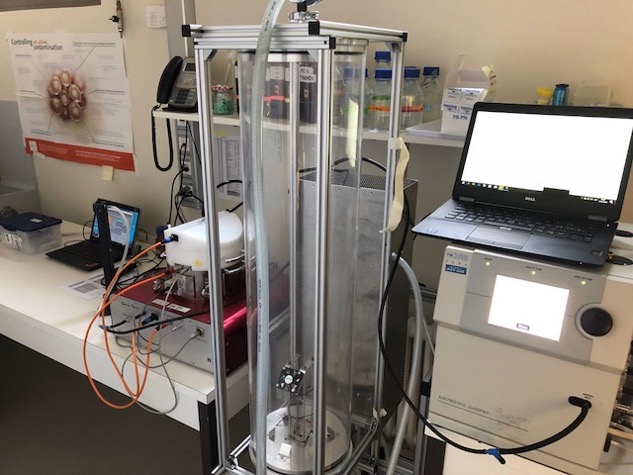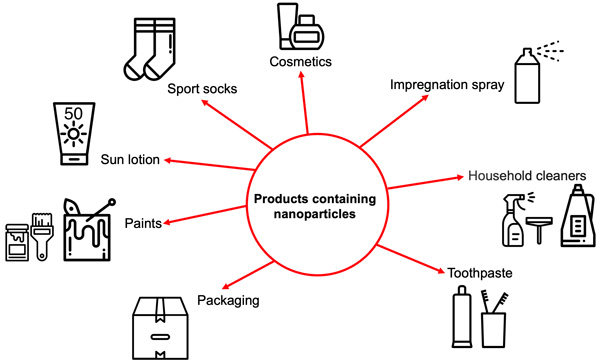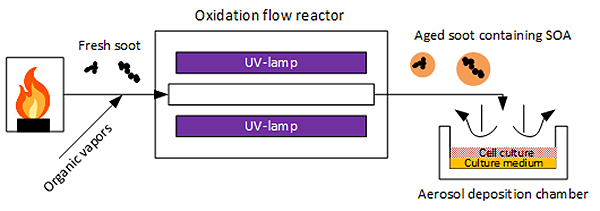 Nano Aerosol Chamber In-Vitro Toxicity
Nano Aerosol Chamber In-Vitro Toxicity
Effects of inhaled nanoparticles to normal and diseased airway epithelia by in vitro technology
Applications
Nanoparticles in powders, dispersions or sprays pose a yet unknown risk for incidental exposure, especially in persons with lung disease, children and the elderly. Safety testing of abundant engineered nanoparticles (ENP) is performed in cells from normal and diseased lungs using the novel, portable and realistic nano aerosol deposition chamber NACIVT.
Background
Safe application of the quickly growing nanotechnology requires a comprehensive clarification of effects on people and the environment. Inhalation of ENP in the processing industry and by consumer products poses a yet unknown risk. Thereby individuals with chronic lung disease, as well as children and the elderly are expected to be more vulnerable than healthy adult subjects. Safety testing needs to include studies in the susceptible population. Furthermore, for efficient, economical, and ethically sound toxicity testing, animal-free test systems are needed that represent real inhalation conditions.
Aim
This research aims at assessing health impacts of inhaled, widely used ENP on normal adults and persons with the most prevalent lung diseases using a specially developed test unit. Experiments are performed using cell cultures that replicate the primary target of inhaled particles, i.e. the airway epithelium. We investigate whether and how the most important defense systems of the lungs are affected by the nanoparticles and whether the inflammatory response of the airway epithelium is altered. We expose the cell cultures in the new aerosol deposition chamber NACIVT to ENP out of a continuous air-stream, like within the respiratory tract. The chamber is mobile, to be used at any particle source of interest. Dose-response curves are established in air-liquid interface cell cultures from lungs of normal and diseased human donors.
Significance
The research aims to better understand the potential toxicity of inhaled ENP and the underlying biological mechanisms. The newly developed system is unique as it fulfils all requirements for realistic in vitro testing: accurate aerosol deposition, cell cultures replicating the inner lung surface and quantitative measurements of relevant cellular responses. The system is versatile, as it can be used for a wide range of particles, cell cultures and particle sources. The anticipated comprehensive combined mechanical and biological unit will likely advance the knowledge about possible adverse effects of inhaled ENP to the respiratory system. Currently, NACIVT is already used by renowned researchers at universities and companies in the USA, in Canada and in Europe.
E-cigarettes
Whereas e-cigarettes and the heated tobacco device IQOS are advertised as harmless alternative to conventional cigarettes, there is increasing evidence that they also cause adverse health effects. To investigate this, we developed an instrument to generate representative e-cigarette vapors for physicochemical particle characterization and to study these vapors using the NACIVT. The device allows simulating a realistic smoking situation. Several e-cigarettes, belonging to different generations and an IQOS were tested. Results show that a single, short exposure to e-cigarette aerosol caused subtle, e-device dependent changes of cell morphology and cytotoxicity in fully differentiated human bronchial epithelia. Information that is more detailed is given in Delaval M. et al., 2019.

Mathilde Delaval, Daniel Egli, Patrick Schüpfer, Charaf Benarafa, Marianne Geiser, Heinz Burtscher: Novel instrument to generate representative e-cigarette vapors for physicochemical particle characterization and in-vitro toxicity, Journal of Aerosol Science, 129, 2019, 40-52, https://doi.org/10.1016/j.jaerosci.2018.11.011.
Jet-emissions
Aircraft emissions contribute to local and global air pollution. Health effects of particulate matter (PM) from aircraft engines are largely unknown, since controlled laboratory studies reflecting realistic conditions are challenging. We combined direct turbine-exhaust sampling under realistic engine operating conditions and the NACIVT to deposit particles onto air–liquid-interface cultures of human bronchial epithelial cells. Cellular toxicity and pro-inflammatory responses were observed after a short 1-h exposure to non-volatile PM (nvPM) emissions, depending on the fuel type and the engine operating conditions. PM from conventional fuel at ground-idle conditions was found to be the most hazardous. Information that is more detailed is given in Delaval M. et al., 2022 and Jonsdottir H. et al., 2019, 2018.

Mathilde N. Delaval, Hulda R. Jonsdottir, Zaira Leni, Alejandro Keller, Benjamin T. Brem, Frithjof Siegerist, David Schönenberger, Lukas Durdina, Miriam Elser, Matthias Salathe, Nathalie Baumlin, Prem Lobo, Heinz Burtscher, Anthi Liati, Marianne Geiser (2022). Responses of reconstituted human bronchial epithelia from normal and health-compromised donors to non-volatile particulate matter emissions from an aircraft turbofan engine. Environmental Pollution, 307, 2022, 119521, https://doi.org/10.1016/j.envpol.2022.119521.
Hulda R. Jonsdottir, Mathilde Delaval, Zaira Leni, Alejandro Keller, Benjamin T. Brem, Frithjof Siegerist, Daniel Schönenberger, Lukas Durdina, Mirjam Elser, Heinz Burtscher, Anthi Liati, Marianne Geiser (2019). Non-volatile particle emissions from aircraft turbine engines at ground-idle induce oxidative stress in bronchial cells. Nature Communications Biology, 2:90, 2019, https://doi.org/10.1038/s42003-019-0332-7.
Hulda R. Jonsdottir, Mathilde Delaval, Zaira Leni, Alejandro Keller, Benjamin T. Brem, Frithjof Siegerist, Daniel Schönenberger, Heinz Burtscher, Anthi Liati, Marianne Geiser (2018). Respiratory Health Effects of Non-Volatile Particle Emissions from an Aircraft Turbine Engine. American Journal of Respiratory and Critical Care Medicine, 197, Session A70, Conference Abstract: A2271, International Conference of the American-Thoracic-Society, San Diego, CA, MAY 18-23, 2018. https://www.atsjournals.org/doi/abs/10.1164/ajrccm-conference.2018.197.1_MeetingAbstracts.A2271.
Nanomaterials
Individuals with chronic pulmonary diseases are likely more vulnerable to adverse effects by inhalation of engineered nanoparticles (ENP) than normal subjects. We exposed fully differentiated normal and cystic fibrosis (CF) human bronchial epithelia and human bronchial epithelial cells (BEAS-2B) to three different doses of spark-generated aerosols of silver and carbon particles (20 nm diameter). Differences in biological markers between differentiated bronchial epithelia and BEAS-2B cells suggest that primary cells are a more accurate model to study potential health effects of ENP. Higher constitutive levels of apoptotic cell death and cytokine secretion in CF compared to normal HBE may contribute to the deterioration of CF patients' respiratory health. The findings support epidemiologic evidence that subjects with chronic airway diseases are more vulnerable to adverse effects of particulate air pollution. This demonstrates the necessity to include this sub-population in nano-toxicity studies. Information that is more detailed is given in Jeannet et al., 2016.

Natalie Jeannet, Martin Fierz, Sarah Schneider, Lisa Künzi, Nathalie Schmid, Matthias Salathe, Heinz Burtscher, Marianne Geiser (2016). Acute toxicity of silver and carbon nanoaerosols to normal and cystic fibrosis human bronchial epithelial cells. Nanotoxicology 10(3):279-291 (2016), https://doi.org/10.3109/17435390.2015.1049233.
Ambient aerosol
Fireworks are most popular during the Spring Festival in China, significantly increasing the levels of particulate matter (PM) and gaseous pollutants. To evaluate the toxicological impact on the lungs, we exposed macrophages to the whole stream of outdoor air at the air−liquid interface and measured as signature molecules the expression patterns of microRNAs. In cells exposed during the New Year's night, we found up- and downregulation of miRNAs with target genes linked to immunity and inflammation pathways. In cells exposed during the daytime of the Chinese New Year with higher concentrations of particles, SO2 and nitrogen oxide, the target genes of the up-regulated miRNAs were mostly linked to apoptosis, cell adhesion and junction-related pathways. The results obtained help unravelling toxic mechanisms of air constituents and main drivers of air pollution-induced disorders.
** Image: Fireworks **
Jie Ding, Jincheng Guo, Liming Wang, Yandong Chen, Bin Hu, Yiye Li, Rujin Huang, Junji Cao, Yuliang Zhao, Marianne Geiser, Qing Miao, Ying Liu, Chunying Chen. Cellular Responses to Exposure to Outdoor Air from the Chinese Spring Festival at the Air-Liquid Interface. Environmental Science and Technology, 53(15):9128-9138 (2019), https://doi.org/10.1021/acs.est.9b00399.
Secondary organic aerosol (SOA)
Secondary organic aerosol (SOA) formed from gaseous precursors constitutes a major mass fraction of fine particulate matter. To have a better understanding of the toxicological effects, we generated fresh and aged soot particles of 30 and 90 nm diameter and coated them with increasing amounts of secondary organic matter (SOM) from anthropogenic (mesitylene) and biogenic (alpha-pinene) precursors. Exposure of air–liquid interface cultures of human bronchial epithelia to these aerosols resulted in cell membrane damage and proteome analysis indicated SOM coating and bioavailability to play an important role in cytotoxicity. Moreover, there was evidence for coated particles to affect epithelial barrier functions, cell remodeling and inflammatory activity.

Zaira Leni, Michaela N. Ess, Alejandro Keller, James D. Allan, Heidi Hellén, Karri Saarnio, Katie R. Williams, Andrew S. Brown, Matthias Salathe, Nathalie Baumlin, Konstantina Vasilatou, Marianne Geiser. Role of secondary organic matter on soot particle toxicity in reconstituted human bronchial epithelia exposed at the air–liquid interface. Environmental Science and Technology (2022), https://doi.org/10.1021/acs.est.2c03692.